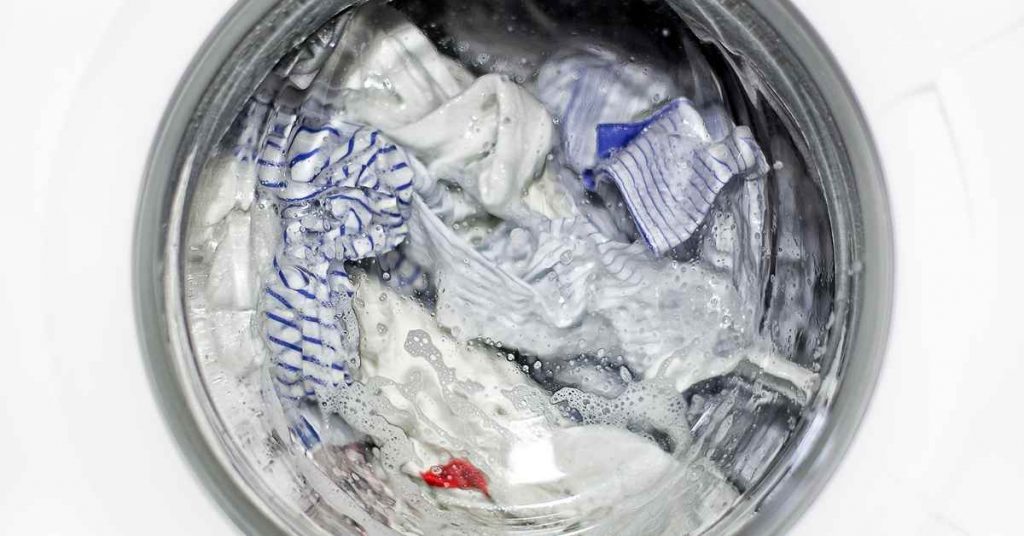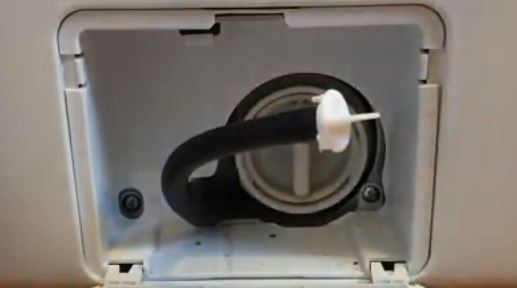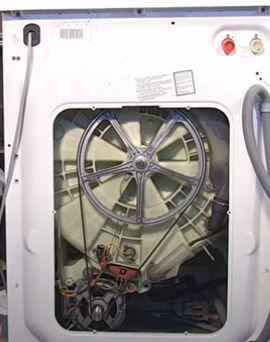
A washing machine that won’t spin can be due to various issues, some of which are relatively simple to address, while others may require professional assistance. Here’s a brief summary of common reasons why a washing machine won’t spin:
- Unbalanced Load: If the load inside the washing machine is unbalanced, it can trigger safety mechanisms that prevent the machine from spinning to avoid damage. Re-distribute the load evenly inside the drum.
- Lid or Door Switch: Most washing machines have a safety switch that prevents spinning when the lid or door is open. Check if the lid or door is securely closed and the switch is functioning correctly.
- Drive Belt: The drive belt connects the motor to the drum. If it’s broken or loose, the drum may not spin. Inspect the belt for damage and tension. Replace or adjust it as needed.
- Lid Lock or Door Lock Mechanism: Some modern washing machines have a lid or door lock that must engage properly for the machine to spin. Check if the lock mechanism is functioning correctly.
- Motor Coupling: The motor coupling connects the motor to the transmission. If it’s worn or damaged, the machine may not spin. Inspect and replace the motor coupling if necessary.
- Clutch Assembly: The clutch assembly engages and disengages the transmission to control spinning. If it’s worn or faulty, it may need replacement.
- Transmission or Gearcase Problems: Issues with the transmission or gearcase can prevent the drum from spinning. A technician may need to diagnose and repair these components.
- Lid Switch Bypass or Control Board Issues: Attempting to bypass the lid switch for convenience can lead to spinning problems. Additionally, control board malfunctions can affect spinning. Consult a professional technician to diagnose and repair these issues.
- Drive Motor Problems: If the drive motor is malfunctioning or has electrical issues, it may not provide the necessary power for spinning. Test the motor for continuity and repair or replace it if needed.
- Faulty Start Capacitor (for top-loading machines): Top-loading washing machines often use start capacitors. If this component fails, it can affect the motor’s ability to start and spin. Test the capacitor and replace it if defective.
- Overloaded Machine: Overloading the washing machine can strain the motor and prevent it from spinning. Avoid overloading and follow the recommended load capacity.
- Worn Bearings: If the drum’s bearings are worn, it can cause excessive friction and prevent spinning. This typically requires professional repair, often involving drum replacement.
How to Fix a Washer that Won’t Spin

When you want to fix a washer that won’t drain, start with the easy fixes. You might be surprised by just how easy fixing the problem can be.
The following are the different methods of fixing a washing machine that is not spinning:
1. Level Up the Washer
You need to know that the washer tub is usually suspended inside the drum in order for it to spin freely. Why is this a problem though?
When the drum is spinning, a centrifugal force is produced. Don’t about this terminology. Centrifugal force is a force that acts on a body moving in a circular motion, and drives the body away from the center.
In this case, your laundry load and water are the body in motion inside the drum. If the washer is resting on level surface, this is not a problem since the force is evenly distributed.
On the other hand, if the washer is placed in an uneven surface (or it is tilting to one side), the centrifugal force will shift the drum to one side. The washer will detect this as an error and it will either spin slowly or will not spin at all.
The solution to this problem is often an easy one. Just position the washer on a flat surface and voila! Back to proper spinning/agitation.
2. Balance the Load
Washing a single or just 2 pieces of laundry causes an imbalance inside the drum which stresses the drum support system as well as other parts. This causes the washer to either spin slowly or not spin at all.
If you have a modern washing machine, it will keep stopping and restarting the spin cycle in a bid to rebalance the load. Others machines will just read this as an error and not spin at all.
Washing a heavy piece of laundry like a towel or blanket forces it to form a lump inside the washer drum. As the drum attempts to spin, the centrifugal force produced by the heavy lump causes the drum to fight to maintains its balance and you might even hear noises coming from the washer.
This problem will also occur if you have a load consisting of one heavy piece like comforter and lightweight clothes like soaks, underwear, T-shirts etc. The weight of the light clothes is not enough to counter the weight of the comforter thereby creating an imbalance in the drum.
To fix this issue, wash several heavy clothing in one wash to create a proper balance in the drum. As you load the clothes, make sure they are not entangled to prevent creating one big an unbalanced lump in the drum.
While at it, avoid overstuffing the washer. Each washer has its load bearing capacity which when exceeded will have the machine not spinning/working as designed.
If you already have a washer which you suspect you have overloaded, open the door and remove some of the load and start the cycle again.
3. Reset the Motor
This will not work on all washing machines but it will do on others ( top-loading washers with a direct-drive system, which does not need a transmission system to spin). Resetting a washer motor will not even take you a minute to complete.
If a washer senses something out of the usual like an unbalanced load, power spike or a disruption in power, it will send a fault code to the motor which will shut down the drive system. If all of a sudden your washer is not spinning and you have experienced issues with your power supply, try to reset the motor before opening it up.
This is how to reset a washer motor:
- Unplug the washer from the power outlet.
- Wait for approximately one minute and then plug in the washer back to the power outlet.
- Lift and lower the lid 6 times within 30 seconds of plugging the washer. Please note that once you start lowering and lifting the lid, you must complete the cycle within 12 seconds.
You don’t need to lift the lid all the way up. 2 inches is sufficient. The aim is to make and break contact with the lid switch 6 times within that time duration. In some washer models you may hear a click sound once the contact is made.
If you are lucky, this easy fix is enough to get your washer spinning properly again.
4. Check the Lid Switch
If your top-loading washer is not spinning, you could be dealing with a faulty lid switch. A washing machine with a broken or stuck lid switch will not spin or even drain.
Depending on the washer model you have, a lid switch can either be visible or invisible. If it is visible, you will see a small protrusion on the underside of the lid.
To check if the lid switch is faulty or not, try to depress it with a finger. If you hear it click then it is good. On the other hand, if it doesn’t click it is definitely broken and will need a replacement.
In some models, the lid switch is positioned under the lid hinge. You can hear it click when you lower and raise the lid if it is good. If someone had placed a heavy load or even sat on top of the washer, the lid switch could be stuck.
Lift the lid and press its underside with your palm if you notice a dent on it. If that does fix it, you will need more tests including electric continuity to check if it is indeed faulty. Fixing/replacing a lid switch is quite easy as shown in this video.
5. Unclog a Washer that Won’t Drain
If a washer won’t drain water, it will as well not spin. A washer that won’t drain is caused by a clog in the drain hose, pump or even the washing machine drainpipe itself.
The first thing to do is to unplug the washer from the power outlet and pull it forward to give you space to work with. Check the drain hose for kinks and bends which could prevent it from draining properly. Straighten them up if any.
If the drain hose it is not kicked or bent, it could be clogged. Another problem could be a clogged drain pump. This is often caused by small pieces of clothing like socks and underwear, or even pieces like coins or hair clips.
Accessing a washing machine drain pipe will depend on the type of washer you have. In some models you will need to remove the entire front or back panel while some modern washers have a small access panel ( also know as coin trap) at the front which lets you easily pull out the filter and clean it.

If this is what you have, pull down the tab on the panel to release it. You will see a small hose (usually black). If you need to drain the washer, pull out the plug on the hose and drain out the water into bucket.
Note: To drain other types of washers you will need to do it from the drain hose at the back of the washer, or bail out the water using a cup and bucket. A shop vac will also suffice.
Adjacent to the small drain hose is the washer filter. Turn it counterclockwise to loosen and remove it. If your washer was unable to drain, you will find the clog there. Clean it and put it back together with the drain hose.
If your washing machine does not have a coin trap, the clog will be found in the drain pump itself or the drain hose. If you are unlucky, a piece like a coin can break the motor impellers and will need to be replaced.
I have written a detailed article on how to fix a washer that will not drain. Read it here.
6. Replace Worn Out Motor Carbon Brushes
If your washer is not spinning but you can hear the motor kick in amid a cranking noise then the motor carbon brushes are worn out and will need to be replaced. To do this, you will need to first remove the washer’s back panel to access and remove the motor.

The washer carbon brushes transfer electric power to the motor armature. A belt drive is then connected from the motor to the washer drum via a pulley.
When the motor armature is supplied with the power, it will spin and the motion will be transferred to the washer drum by the drive belt.
To make sure that the carbon brushes are in contact with the motor armature, they are usually spring-loaded. Once the carbon brushes are worn out, the contact will be lost and the motor will not spin, meaning the washer will not spin as well.
If you would like to see how to replace worn out washer carbon brushes check out this video on You Tube.
7. Realign or Replace the Drive Belt

A washing machine drive belt is responsible for transferring motion from the motor to the drum. The belt is hooked on the motor as well as drum pulley.
Due to wear and tear, the drive belt can tear off meaning that even though the motor is spinning, power is not being transferred to the drum. Sometimes the belt will just jump out of the pulley and all you need to do is simply put it back.
If you are going to buy a replacement drive belt, check out the serial number on the one old one and order an exact match. This is actually a really simple fix.
8. Inspect the Motor Coupler
A motor coupler is a small plastic and rubber piece that connects the motor and the washer transmission. If it is broken, you will hear an unusual noise when you start the washer.
To test whether you washer motor coupler is broken, start a wash cycle and let the drum fill with water. When the water level in the drum reaches the point where the agitation should start but instead you the motor kicks in but the washer won’t spin, you need to replace the motor coupler.
A new motor coupler is pretty cheap but installing it will take some time, depending on your level of skill. The video below illustrates how to replace a washer motor coupler.
